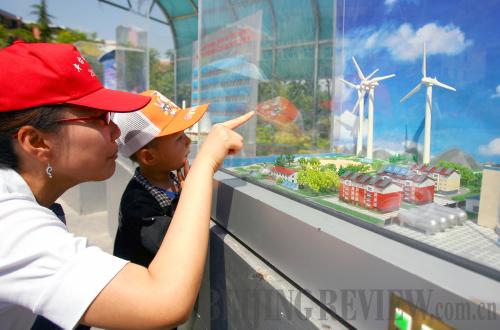|
Communities benefit
 |
|
GREEN TECHNOLOGY: Beijing residents observe the model of a wind power generator (RU TAO) |
In the communities where the projects have been piloted, residents are enjoying its fruits.
Qinghuayuan is a residential area neighboring one of China's top universities, Tsinghua University. It is served by a technical support and consulting team of about 80 persons, some of whom are from the university's Department of Computer Science and Technology.
It is expected about 10 of the most recent research results will be applied in the community, including a GPS satellite positioning system as well as health monitoring and electric archive retrieval systems. Many of the community's residents are retired professors or researchers, so some of the technology has been specifically tailored to meet seniors' needs.
Residents in Yuetan community in Xicheng District can now access education resources of famous universities at home through an e-learning system. The community has its own portal, and households are connected via various networks such as optical fiber and wireless networks. Tsinghua University developed the e-learning technology and adapted it for the community.
In Haidian District, residents can even order meals or other goods or services by pointing a remote control at a TV's set-top box. Through the server of an interactive Digital TV System, residents can upload requests to a community network information center, which will quickly process the information, and provide feedback via instant messenger or telephone.
Information technology is also widely used in Chongwen District. This digitalized community boasts of an e-government office system, a community internet portal and a video conference system. Light emitting diode (LED) screens have been installed in prominent positions in the area to display science and technology information.
Intercommunications system and video surveillance networks have been installed in more than 100 buildings in the community. The information thus provided is shared between the community, the city's emergency command system and the police.
The community also uses radio frequency identification (RFID) tags to manage traffic. A RFID tag is a tiny device containing a computer chip that stores information . The tag can be attached to cars, and read by a scanner at a distance. As a resident's car approaches a garage, the scanner will recognize the car and the garage door will open and shut automatically. In addition to controlling garage access, an RFID tag can be programmed to automatically calculate available parking lots and remind drivers of other important information.
Bai Huafan, a 77-year-old living in Beijing's Xuanwu District, says she feels her life has been enhanced by the pilot project. She lives with her husband and her 98-year-old mother. "All three of us are hard of hearing due to old age, so we worry about our safety," she said, "now, with an electronic security monitoring system guarding our home, we feel safer."
The monitoring system is connected to wireless door magnetic sensors. Whenever a door or window is opened, the sensors trigger surveillance cameras. The system can send pictures and messages to the residents' cellphones. If a home is broken into, the information will help the police to catch criminals.
The surveillance cameras can also be remotely operated by residents. Away from home, a resident can "observe" what is happening at home at any time by sending cellphone messages or using a remote control.
Niujie Street in Xuanwu District is an area inhabited by residents from 23 ethnic groups, including Hui, Uygur and Mongolian. To accommodate the diversity, the community resident committee issued more than 1,000 questionnaires and hosted focus group meetings to learn about the residents' science and technology' needs and chose the desired products accordingly. The government then paid for the installed equipment. | 